Pneumonia Nursing Education for Discharge
VerifiedAdded on 2020/04/21
|6
|1581
|337
AI Summary
This assignment focuses on developing a nursing education plan for Ms. Azizi upon her discharge following treatment for pneumonia. It outlines three key areas of education: promoting fluid intake to thin secretions, practicing proper hand hygiene to prevent infections, and learning breathing exercises to enhance lung function. The rationale for each teaching point is directly related to Ms. Azizi's reasons for admission and potential complications.
Contribute Materials
Your contribution can guide someone’s learning journey. Share your
documents today.
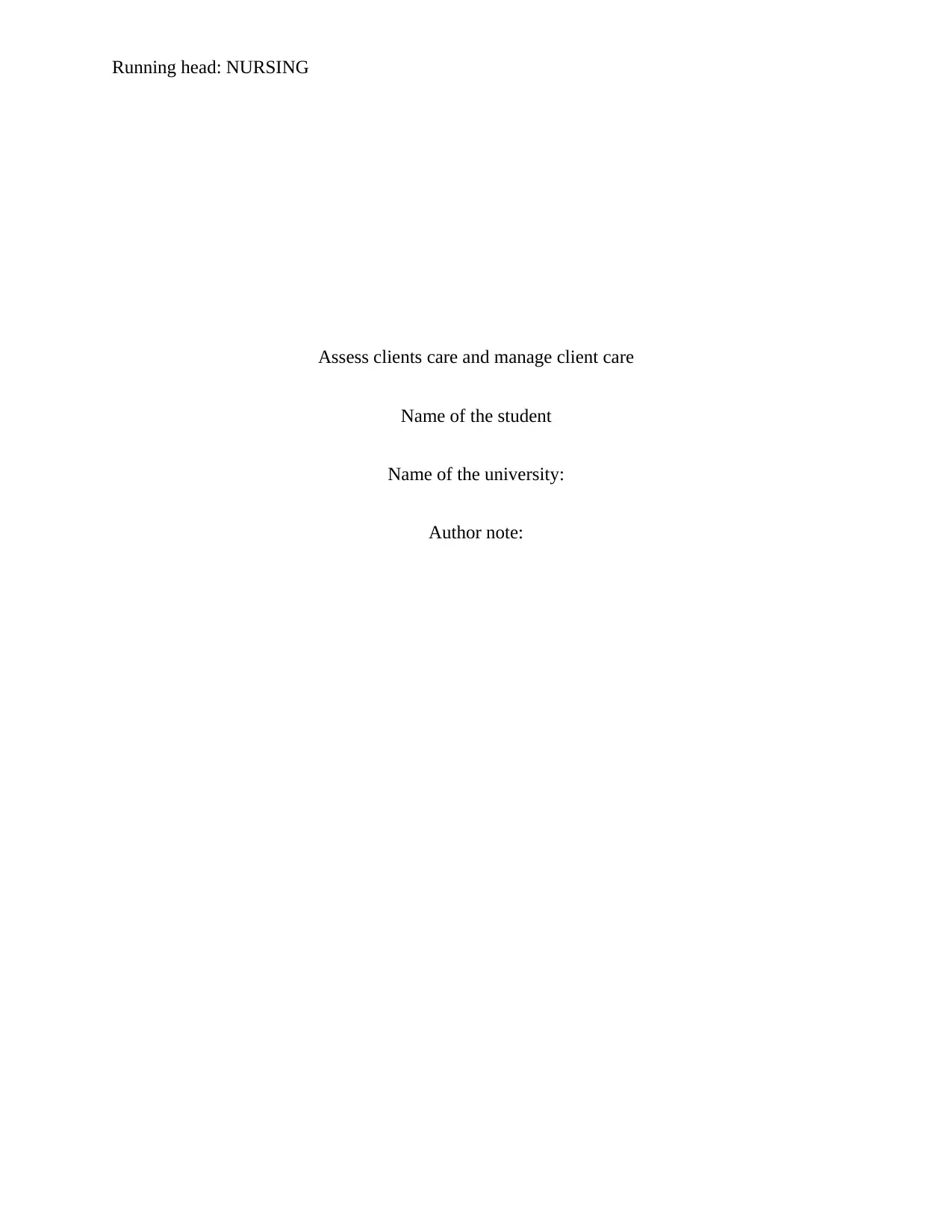
Running head: NURSING
Assess clients care and manage client care
Name of the student
Name of the university:
Author note:
Assess clients care and manage client care
Name of the student
Name of the university:
Author note:
Secure Best Marks with AI Grader
Need help grading? Try our AI Grader for instant feedback on your assignments.

1NURSING
PART 1: Nursing Assessment
CNS In this part the level of consciousness is measured of Ms. Azizi, as the patient is
having dyspnoea which is a clinical sign of hypoxia (Hayden et al., 2015).
CVS According to the case study, the vital signs include blood pressure and heart rate.
Next the general inspection was done about the appearance of Ms. Azizi and the
way she responds to activity. As per the case study, Ms.Azizi has a past medical
history of hypertension; hence it is important to assess the blood pressure and the
heart rate (Sørensen et al., 2013).
Respiratory This case study is mainly concentrating on the Respiratory rate, O2 saturation and
chest auscultation that would be necessary for Ms. Azizi as she is suffering from
short of breath and has cough due to Pneumonia (Chavez et al., 2014).
GIT & metabolic This assessment is done mainly for abdominal pain and asked Ms. Azizi about the
history of abdominal health because she was complaining about nausea, stomach
cramps and loose bowels for overnight. (Musher & Thorner, 2014).
Renal This assessment studies the elimination of fluid and inspection of urinary pattern,
also the fluid balance chart. As Ms. Azizi mentions about having loose bowel
overnight, it might indicate Ms. Azizi’s fluid balance status. The kidneys used to
maintain a responsive balance in the excretion and retention of the fluids. If the
concentration of the fluids and the electrolyte solutes are in a state of equilibrium,
than the increase in the intake of the fluid results in the increase of the production
of udine.(Almirall et al., 2015).
Skin This assessment deals with the inspection of skin, determining the colour,
moisture, temperature, Oedema and texture. Assessment of skin can reveal a
variety of skin conditions, including changes in oxygenation, circulation, nutrition,
local tissue damage and hydration (Huijskens et al. 2013).
PART 1: Nursing Assessment
CNS In this part the level of consciousness is measured of Ms. Azizi, as the patient is
having dyspnoea which is a clinical sign of hypoxia (Hayden et al., 2015).
CVS According to the case study, the vital signs include blood pressure and heart rate.
Next the general inspection was done about the appearance of Ms. Azizi and the
way she responds to activity. As per the case study, Ms.Azizi has a past medical
history of hypertension; hence it is important to assess the blood pressure and the
heart rate (Sørensen et al., 2013).
Respiratory This case study is mainly concentrating on the Respiratory rate, O2 saturation and
chest auscultation that would be necessary for Ms. Azizi as she is suffering from
short of breath and has cough due to Pneumonia (Chavez et al., 2014).
GIT & metabolic This assessment is done mainly for abdominal pain and asked Ms. Azizi about the
history of abdominal health because she was complaining about nausea, stomach
cramps and loose bowels for overnight. (Musher & Thorner, 2014).
Renal This assessment studies the elimination of fluid and inspection of urinary pattern,
also the fluid balance chart. As Ms. Azizi mentions about having loose bowel
overnight, it might indicate Ms. Azizi’s fluid balance status. The kidneys used to
maintain a responsive balance in the excretion and retention of the fluids. If the
concentration of the fluids and the electrolyte solutes are in a state of equilibrium,
than the increase in the intake of the fluid results in the increase of the production
of udine.(Almirall et al., 2015).
Skin This assessment deals with the inspection of skin, determining the colour,
moisture, temperature, Oedema and texture. Assessment of skin can reveal a
variety of skin conditions, including changes in oxygenation, circulation, nutrition,
local tissue damage and hydration (Huijskens et al. 2013).
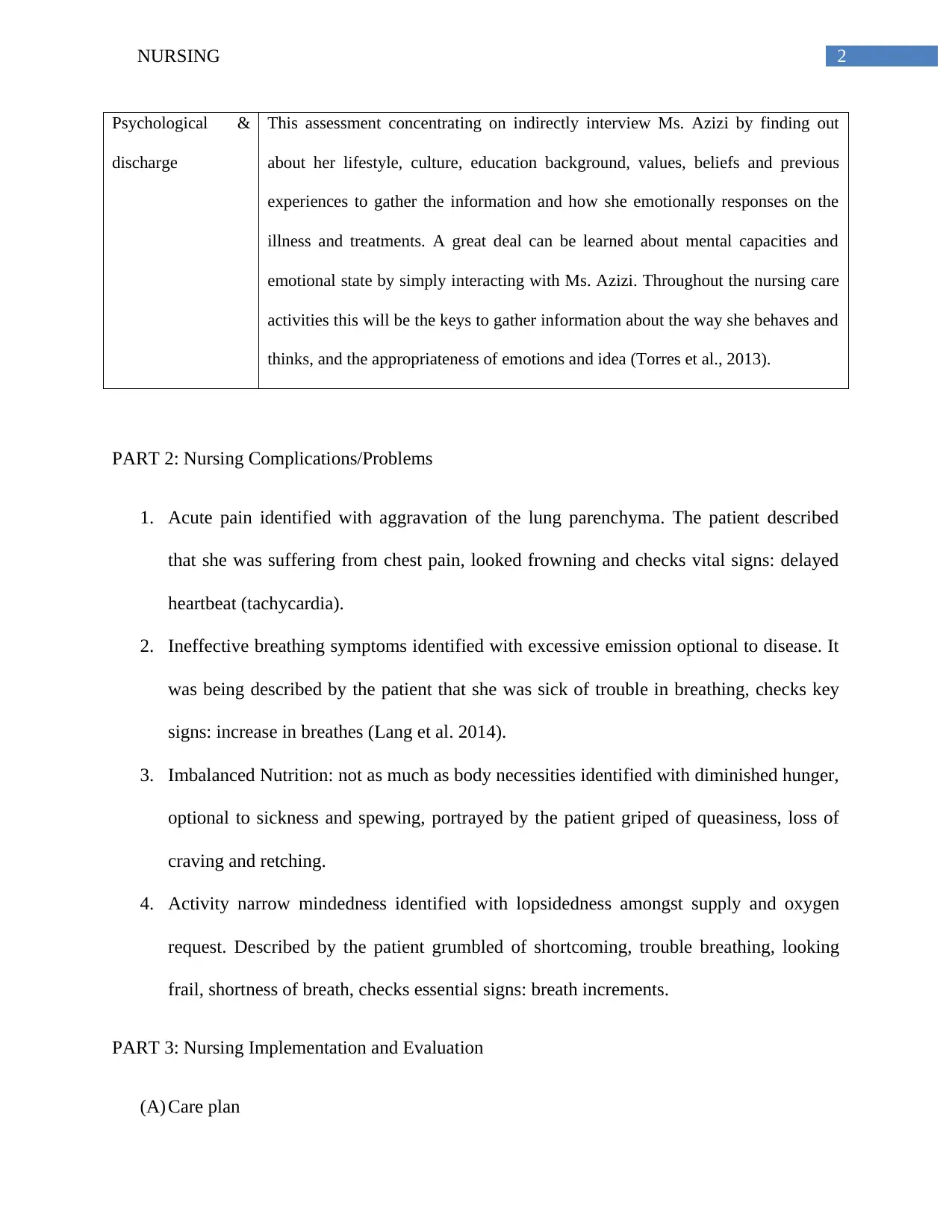
2NURSING
Psychological &
discharge
This assessment concentrating on indirectly interview Ms. Azizi by finding out
about her lifestyle, culture, education background, values, beliefs and previous
experiences to gather the information and how she emotionally responses on the
illness and treatments. A great deal can be learned about mental capacities and
emotional state by simply interacting with Ms. Azizi. Throughout the nursing care
activities this will be the keys to gather information about the way she behaves and
thinks, and the appropriateness of emotions and idea (Torres et al., 2013).
PART 2: Nursing Complications/Problems
1. Acute pain identified with aggravation of the lung parenchyma. The patient described
that she was suffering from chest pain, looked frowning and checks vital signs: delayed
heartbeat (tachycardia).
2. Ineffective breathing symptoms identified with excessive emission optional to disease. It
was being described by the patient that she was sick of trouble in breathing, checks key
signs: increase in breathes (Lang et al. 2014).
3. Imbalanced Nutrition: not as much as body necessities identified with diminished hunger,
optional to sickness and spewing, portrayed by the patient griped of queasiness, loss of
craving and retching.
4. Activity narrow mindedness identified with lopsidedness amongst supply and oxygen
request. Described by the patient grumbled of shortcoming, trouble breathing, looking
frail, shortness of breath, checks essential signs: breath increments.
PART 3: Nursing Implementation and Evaluation
(A) Care plan
Psychological &
discharge
This assessment concentrating on indirectly interview Ms. Azizi by finding out
about her lifestyle, culture, education background, values, beliefs and previous
experiences to gather the information and how she emotionally responses on the
illness and treatments. A great deal can be learned about mental capacities and
emotional state by simply interacting with Ms. Azizi. Throughout the nursing care
activities this will be the keys to gather information about the way she behaves and
thinks, and the appropriateness of emotions and idea (Torres et al., 2013).
PART 2: Nursing Complications/Problems
1. Acute pain identified with aggravation of the lung parenchyma. The patient described
that she was suffering from chest pain, looked frowning and checks vital signs: delayed
heartbeat (tachycardia).
2. Ineffective breathing symptoms identified with excessive emission optional to disease. It
was being described by the patient that she was sick of trouble in breathing, checks key
signs: increase in breathes (Lang et al. 2014).
3. Imbalanced Nutrition: not as much as body necessities identified with diminished hunger,
optional to sickness and spewing, portrayed by the patient griped of queasiness, loss of
craving and retching.
4. Activity narrow mindedness identified with lopsidedness amongst supply and oxygen
request. Described by the patient grumbled of shortcoming, trouble breathing, looking
frail, shortness of breath, checks essential signs: breath increments.
PART 3: Nursing Implementation and Evaluation
(A) Care plan
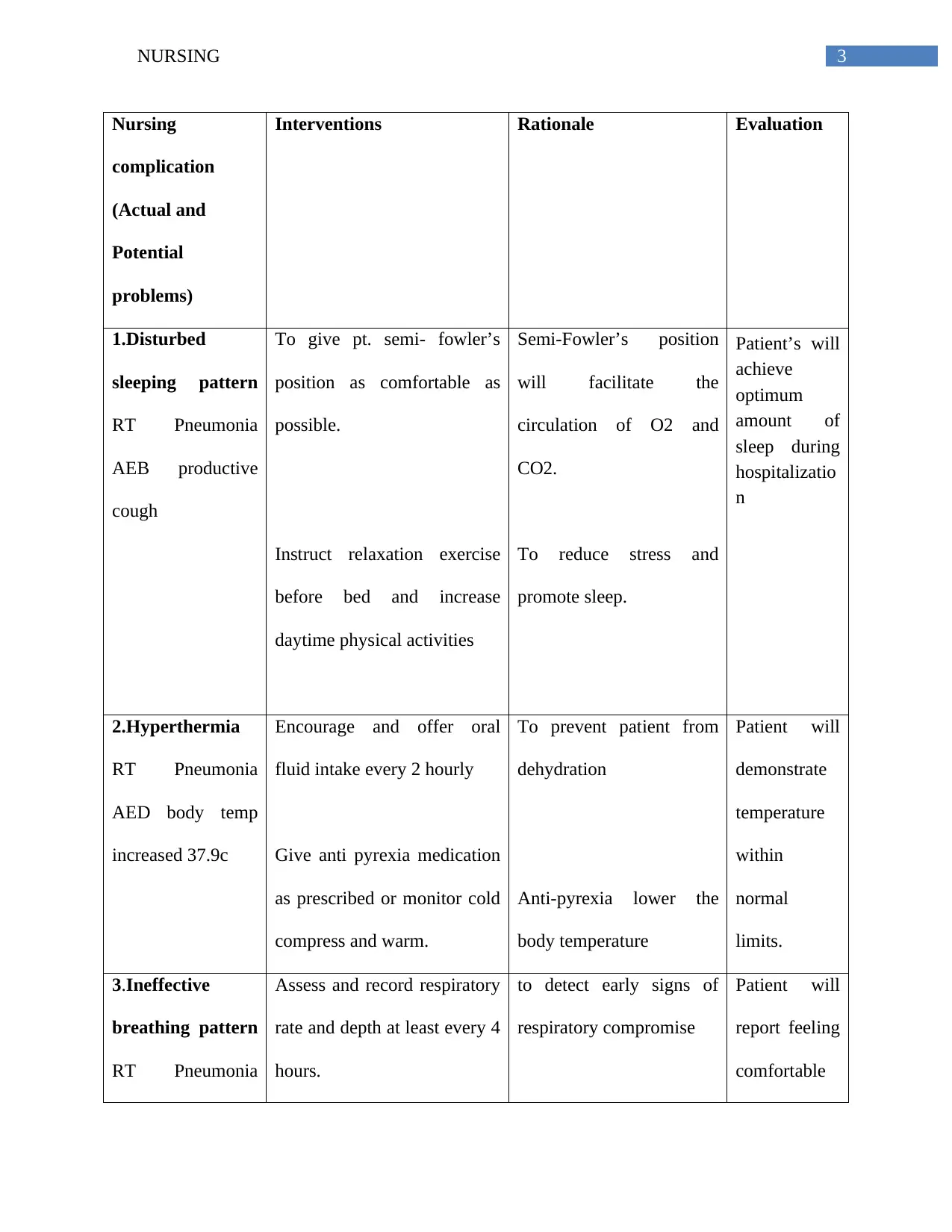
3NURSING
Nursing
complication
(Actual and
Potential
problems)
Interventions Rationale Evaluation
1.Disturbed
sleeping pattern
RT Pneumonia
AEB productive
cough
To give pt. semi- fowler’s
position as comfortable as
possible.
Instruct relaxation exercise
before bed and increase
daytime physical activities
Semi-Fowler’s position
will facilitate the
circulation of O2 and
CO2.
To reduce stress and
promote sleep.
Patient’s will
achieve
optimum
amount of
sleep during
hospitalizatio
n
2.Hyperthermia
RT Pneumonia
AED body temp
increased 37.9c
Encourage and offer oral
fluid intake every 2 hourly
Give anti pyrexia medication
as prescribed or monitor cold
compress and warm.
To prevent patient from
dehydration
Anti-pyrexia lower the
body temperature
Patient will
demonstrate
temperature
within
normal
limits.
3.Ineffective
breathing pattern
RT Pneumonia
Assess and record respiratory
rate and depth at least every 4
hours.
to detect early signs of
respiratory compromise
Patient will
report feeling
comfortable
Nursing
complication
(Actual and
Potential
problems)
Interventions Rationale Evaluation
1.Disturbed
sleeping pattern
RT Pneumonia
AEB productive
cough
To give pt. semi- fowler’s
position as comfortable as
possible.
Instruct relaxation exercise
before bed and increase
daytime physical activities
Semi-Fowler’s position
will facilitate the
circulation of O2 and
CO2.
To reduce stress and
promote sleep.
Patient’s will
achieve
optimum
amount of
sleep during
hospitalizatio
n
2.Hyperthermia
RT Pneumonia
AED body temp
increased 37.9c
Encourage and offer oral
fluid intake every 2 hourly
Give anti pyrexia medication
as prescribed or monitor cold
compress and warm.
To prevent patient from
dehydration
Anti-pyrexia lower the
body temperature
Patient will
demonstrate
temperature
within
normal
limits.
3.Ineffective
breathing pattern
RT Pneumonia
Assess and record respiratory
rate and depth at least every 4
hours.
to detect early signs of
respiratory compromise
Patient will
report feeling
comfortable
Secure Best Marks with AI Grader
Need help grading? Try our AI Grader for instant feedback on your assignments.
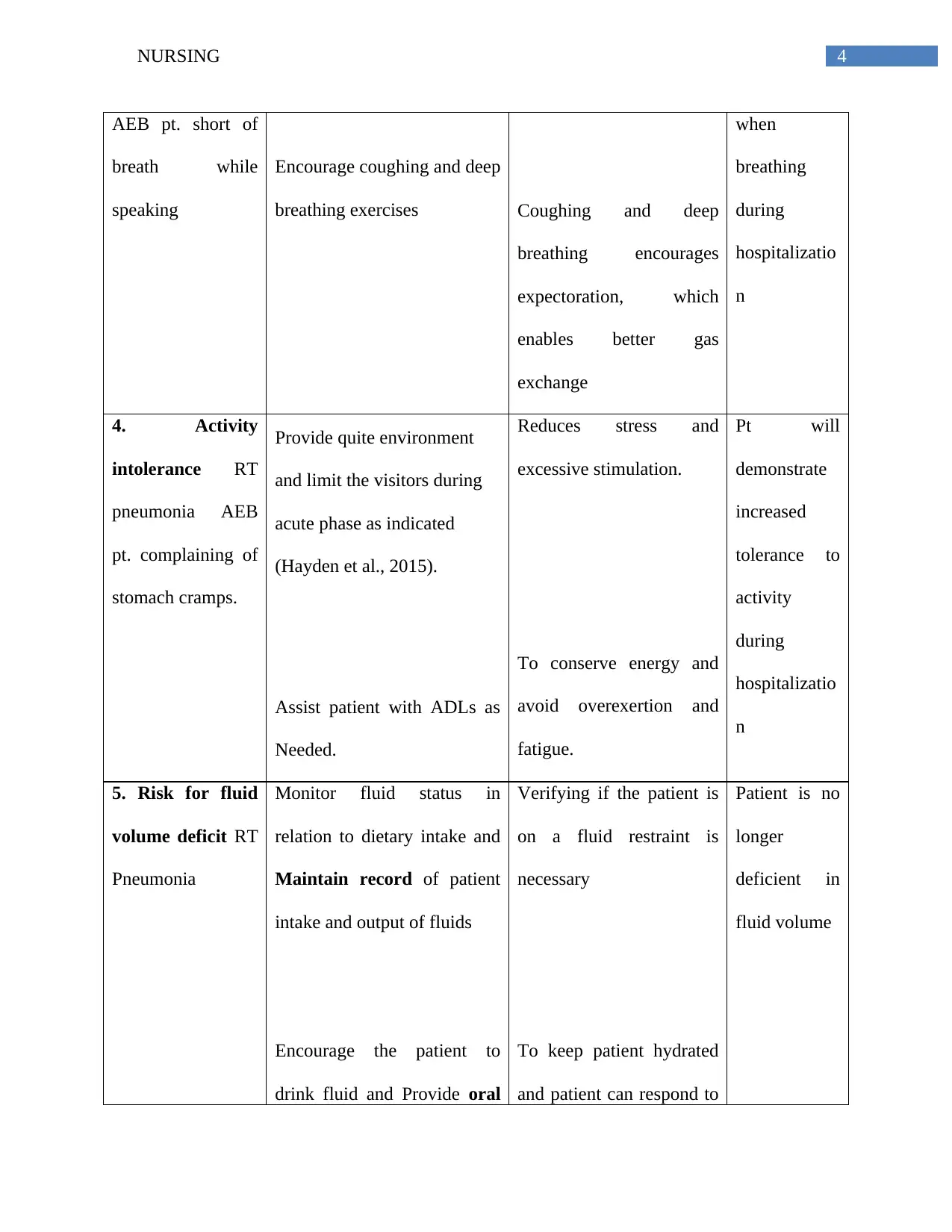
4NURSING
AEB pt. short of
breath while
speaking
Encourage coughing and deep
breathing exercises Coughing and deep
breathing encourages
expectoration, which
enables better gas
exchange
when
breathing
during
hospitalizatio
n
4. Activity
intolerance RT
pneumonia AEB
pt. complaining of
stomach cramps.
Provide quite environment
and limit the visitors during
acute phase as indicated
(Hayden et al., 2015).
Assist patient with ADLs as
Needed.
Reduces stress and
excessive stimulation.
To conserve energy and
avoid overexertion and
fatigue.
Pt will
demonstrate
increased
tolerance to
activity
during
hospitalizatio
n
5. Risk for fluid
volume deficit RT
Pneumonia
Monitor fluid status in
relation to dietary intake and
Maintain record of patient
intake and output of fluids
Encourage the patient to
drink fluid and Provide oral
Verifying if the patient is
on a fluid restraint is
necessary
To keep patient hydrated
and patient can respond to
Patient is no
longer
deficient in
fluid volume
AEB pt. short of
breath while
speaking
Encourage coughing and deep
breathing exercises Coughing and deep
breathing encourages
expectoration, which
enables better gas
exchange
when
breathing
during
hospitalizatio
n
4. Activity
intolerance RT
pneumonia AEB
pt. complaining of
stomach cramps.
Provide quite environment
and limit the visitors during
acute phase as indicated
(Hayden et al., 2015).
Assist patient with ADLs as
Needed.
Reduces stress and
excessive stimulation.
To conserve energy and
avoid overexertion and
fatigue.
Pt will
demonstrate
increased
tolerance to
activity
during
hospitalizatio
n
5. Risk for fluid
volume deficit RT
Pneumonia
Monitor fluid status in
relation to dietary intake and
Maintain record of patient
intake and output of fluids
Encourage the patient to
drink fluid and Provide oral
Verifying if the patient is
on a fluid restraint is
necessary
To keep patient hydrated
and patient can respond to
Patient is no
longer
deficient in
fluid volume
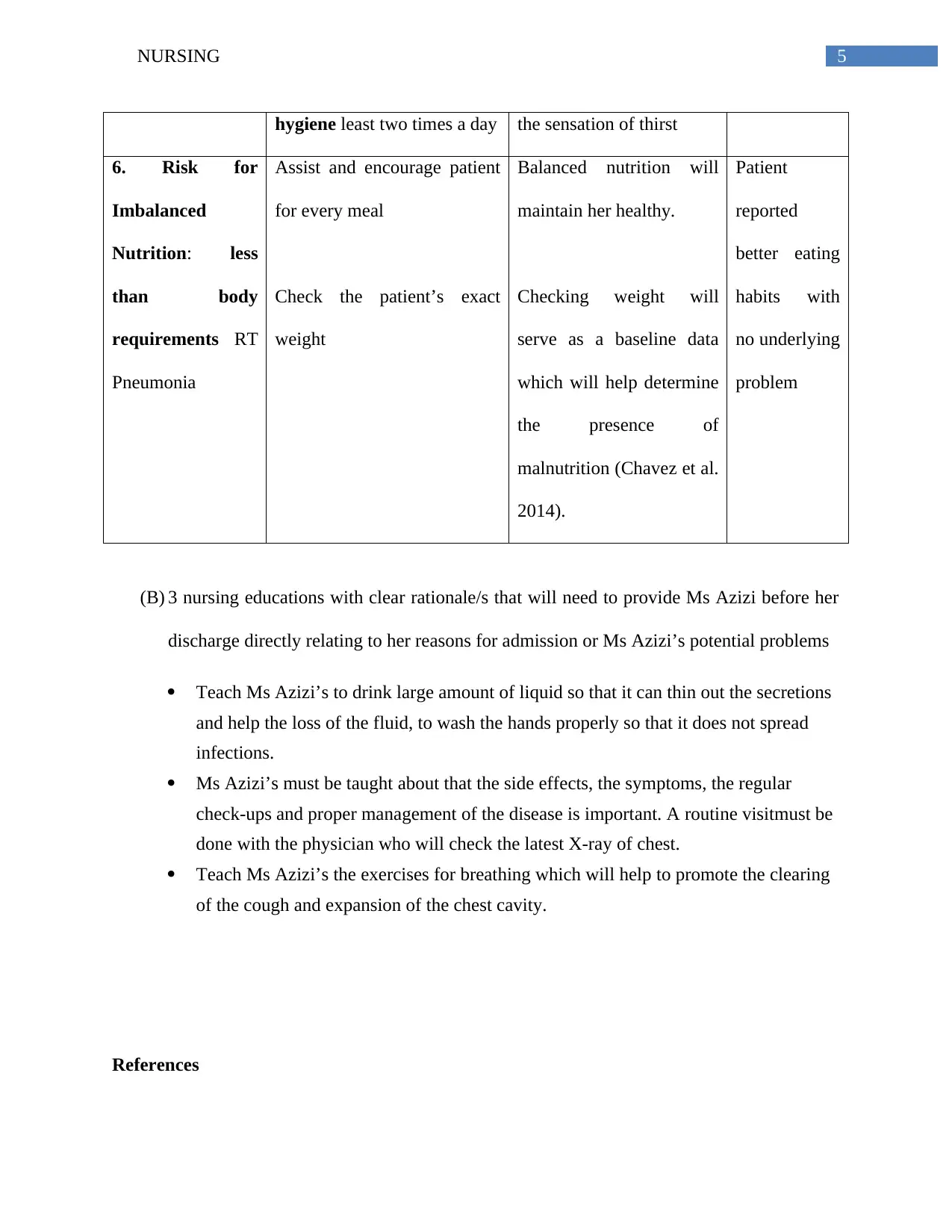
5NURSING
hygiene least two times a day the sensation of thirst
6. Risk for
Imbalanced
Nutrition: less
than body
requirements RT
Pneumonia
Assist and encourage patient
for every meal
Check the patient’s exact
weight
Balanced nutrition will
maintain her healthy.
Checking weight will
serve as a baseline data
which will help determine
the presence of
malnutrition (Chavez et al.
2014).
Patient
reported
better eating
habits with
no underlying
problem
(B) 3 nursing educations with clear rationale/s that will need to provide Ms Azizi before her
discharge directly relating to her reasons for admission or Ms Azizi’s potential problems
Teach Ms Azizi’s to drink large amount of liquid so that it can thin out the secretions
and help the loss of the fluid, to wash the hands properly so that it does not spread
infections.
Ms Azizi’s must be taught about that the side effects, the symptoms, the regular
check-ups and proper management of the disease is important. A routine visitmust be
done with the physician who will check the latest X-ray of chest.
Teach Ms Azizi’s the exercises for breathing which will help to promote the clearing
of the cough and expansion of the chest cavity.
References
hygiene least two times a day the sensation of thirst
6. Risk for
Imbalanced
Nutrition: less
than body
requirements RT
Pneumonia
Assist and encourage patient
for every meal
Check the patient’s exact
weight
Balanced nutrition will
maintain her healthy.
Checking weight will
serve as a baseline data
which will help determine
the presence of
malnutrition (Chavez et al.
2014).
Patient
reported
better eating
habits with
no underlying
problem
(B) 3 nursing educations with clear rationale/s that will need to provide Ms Azizi before her
discharge directly relating to her reasons for admission or Ms Azizi’s potential problems
Teach Ms Azizi’s to drink large amount of liquid so that it can thin out the secretions
and help the loss of the fluid, to wash the hands properly so that it does not spread
infections.
Ms Azizi’s must be taught about that the side effects, the symptoms, the regular
check-ups and proper management of the disease is important. A routine visitmust be
done with the physician who will check the latest X-ray of chest.
Teach Ms Azizi’s the exercises for breathing which will help to promote the clearing
of the cough and expansion of the chest cavity.
References
1 out of 6
Related Documents
Your All-in-One AI-Powered Toolkit for Academic Success.
+13062052269
info@desklib.com
Available 24*7 on WhatsApp / Email
![[object Object]](/_next/static/media/star-bottom.7253800d.svg)
Unlock your academic potential
© 2024 | Zucol Services PVT LTD | All rights reserved.





